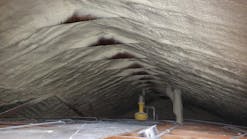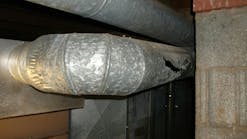"According to the U.S. Department of Labor's Bureau of Labor Statistics, 40% of the HVACR industry is eligible to retire in the next decade," says Howard Weiss, marketing director for the ESCO Group, the HVACR industry's oldest and largest accrediting body, and producers of the Annual HVACR Educators and Trainers Conference.
"During this same period of time, the HVACR service industry is set to grow between 18 to 26%," Weiss says. "The HVACR industry is looking to recruit and train 66% of its current workforce in the next decade."
The good news is, HVACR is getting more attention as a worthwhile, stable, and good-paying career. The December, 2010 edition of US News &World Report included HVACR technicians among the 50 best jobs for 2011.
Industry associations are doing their part. The Mechanical Service Contractors of America (MSCA) and North American Technician Excellence (NATE) have new or existing programs that will help promote the value of trained technicians to homeowners and businesses. The Mechanical Service Contractors of America (MSCA) has initiated Five STAR Careers, an ambitious undertaking. It's main feature is FiveStarCareers.com, which provides information to parents and educators about the benefits of a career in HVACR. It includes the facts that an HVACR technician is a skilled worker who must be qualified to learn, service, and install complicated systems, and have good communications skills.
NATE has launched a new homeowner awareness campaign that, while not exactly designed as a recuriting message, nonetheless champions the talents of NATE-certified technicians, and shows how HVAC professionals contribute to society (see p. 10).
"The earnings, the growth opportunity, the fact that you don't have to work out of service truck forever if you don't want to—and that you can even go into teaching. This is the kind of information we're trying to get the schools to distribute," Weiss says. "This industry is growing, and these jobs can't be sent overseas."
Still, more work needs to be done, and Weiss says it will take more communication, starting yesterday.
"Every contractor should be walking into a school to talk about recruitment, armed with as much information as possible about these potentially $40,000 to $50,000 jobs that can't be sent overseas. We, as an industry, need to be out there talking about the great opportunities," he says.
John Hamilton, with the Testing, Adjusting, and Balancing Bureau (TABB) is a director of the National Energy Management Institute (NEMI), Alexandria, VA. TABB, and the International Certification Board (ICB), provide certified professionals for the HVAC industry.
"How do we spark interest in HVAC? It starts when you say, 'Not everyone goes to college.' That's what makes our program a winner," Hamilton says.
"The Sheet Metal Workers International Association (SMWIA) apprenticeship program has earned an accreditation through the International Training Institute (ITI) in Washington, D.C. They can earn a college degree in HVAC Environmental Sciences through the program. Now, SMWIA can tell high school students, and the parents who say, 'my son or daughter is going to college,' that not only can they earn a college degree, they will earn money while they learn, and owe nothing when they're done. That gets more people involved in HVAC and sheet metal."
Show Industry's Variety, to Raise Interest
Douglas Zentz, associate professor and program coordinator, Ferris State University, College of Engineering and Technology, Big Rapids, MI, says the challenge in filling the HVACR labor pool is impeded by poor student aptitude. As president-elect of the Michigan Chapter of American Society of Heating, Refrigeration, and Air-Conditioning Engineers (ASHRAE), Zentz is someone who knows talent when he sees it.
"One of the biggest problems we have with the youth is, a national movement that's been going on for 10 to 15 years. Fewer students are thinking about anything that has to do with technology or engineering," Zentz says. "The number of college applicants going into post-high school math or science curriculum is going down. They see science, math, technology, and engineering as what the 'non-cool' kids do."
Zentz says it’s important that students of all ages come to know about the various branches of HVACR that go beyond heating and cooling.
"I tell students that we're a society of people who go from building to building all our lives, and those career paths aren't going away," Zentz says. "Plus, those buildings have been identified as the number one cause of energy use and the largest source of emissions. So they can be involved in something that will impact the energy supply and the environment. To them, that's way cooler than just being a 'service tech.'"
Describing more of HVACR's career benefits is indeed a key that can unlock interest, says Tom Tebbe, HVAC Excellence national programs director. In addition to improved screening of students to learn their talents and interests, Tebbe says contractors need to become involved with the schools through advisory committees, and other means.
"Build up the image of the HVACR industry, particularly job opportunities and starting salaries. Make it attractive to a student," says Tebbe, whose family owned 11 HVAC contracting businesses, and who was himself an HVAC business owner, and dean of Louisiana Technical College, West Bank Campus.
"When students first apply to a school, many are looking for which job pays the most money. That may not necessarily be what they're going to enjoy doing all of their life, but, that's what they're looking at. And, they're looking at the length of the program, career paths, opportunities, benefits, and so forth. If the industry did some of those things, HVAC would appear more interesting."
Tom Meyer, director, government/professional relations, ESCO Group, Washington, D.C., would like guidance counselors to understand that not everyone has to attend college. "And, we have to get the government to recognize they shouldn't score schools on their numbers of college entrants only; they should include technical colleges," Meyer says. "We have to help parents understand that there's no shame in being a contractor. Parents have to be supportive of their children, if they decide they'd like to go into the trades."
David Skaves, P.E., instructor at the Maine Maritime Academy (MME), Castine, ME, and author of Fundamentals of HVACR, agrees with Zentz, that there's value in telling students as young as fifth grade about careers in HVACR.
"We invite middle school students to visit MME, because we know that some of those students will eventually migrate into those types of programs," Skaves says. "It's important to show them what's available while they'’re young. If you wait until they’re going into high school, or at the end of high school, it may be too late."
Skaves also believes the high cost of college is coming "home" to roost, in parents' pocketbooks.
"More people I know with sons and daughters in college are tired of the high cost of college," Skaves says. "It's like a bubble that's slowly starting to deflate. They've paid a lot of money, and their son or daughter doesn't have a job. Colleges are too high-priced, the skills the students are learning aren't what industry needs, and there aren't enough positions for graduates. I think there's a transition at work."
Skaves says that transition is one that will result in more qualified students searching for college alternatives, such as HVACR. That's a transition we hope will gather steam, and boil over with a great influx of talented people into HVACR.
NEXT MONTH: We examine recruiting methods of vocational schools, associations, and HVACR contractors









